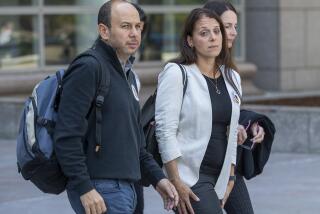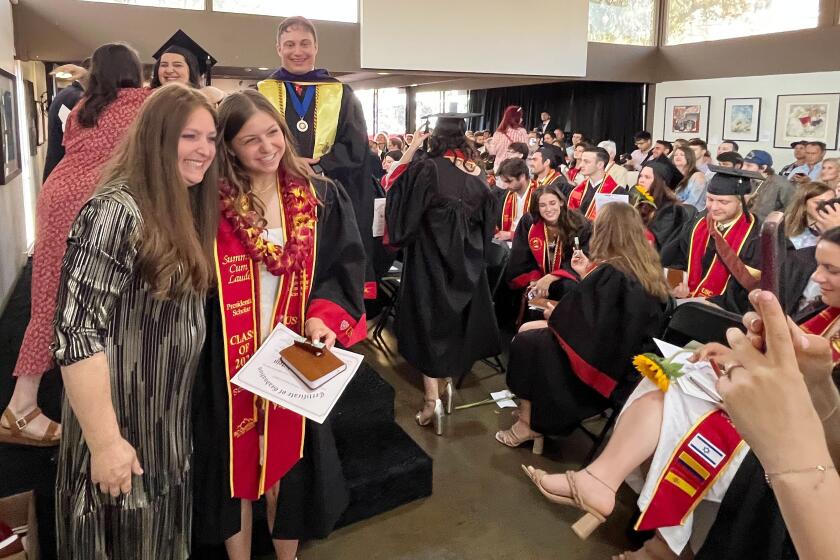Chapman Claws Way to Respect
There’s an old joke law school deans like to tell: What does it take to create a law school as well-known and respected as Harvard?
Answer: $300 million. And 300 years.
Parham Williams likes to repeat it because, as dean of Chapman University’s School of Law, he believes it embraces the ambitious goals he has set for the 7-year-old institution he’s nursed back to health from a troubled beginning: Excellence, built brick by brick over the long haul.
“Starting a law school from ground zero is a huge undertaking,” said the 71-year-old educator, whose former students include author John Grisham and Sen. Trent Lott (R-Miss.). “We learned that you have to have a blueprint to build a house, a road map to find out where you are going.”
When the former University of Mississippi dean was hired by Chapman in 1997, its law school was struggling two years after it opened.
The campus in Orange had been denied provisional approval by the American Bar Assn., which criticized the level of the school’s students, its academic standards and “lax approach” to grading. Applications were in a tailspin. Perhaps most damaging was a lawsuit brought by students who claimed they were misled into thinking ABA approval for Chapman was imminent; the suit eventually led to $1.25 million in tuition refunds.
“There was a lot of naivete about what it meant to have an ABA-accredited operation,” said Joanne Telerico, an associate dean who was brought in by Williams shortly after he arrived to improve, among other things, student recruiting and job-placement efforts.
This fall, Chapman received the ABA’s seal of approval, capping a turnaround fueled by a $31-million endowment and aggressive national recruiting of top students and faculty.
Chapman’s Law School Admission Test (LSAT) scores for 2002 place it in the top third of the nation’s 187 accredited law schools, up from the bottom third in 1996. The goal is to reach the top 20% within three years, which would put Chapman’s law school in the league with those at American University, Rutgers and Ohio State.
Since Williams came aboard, Chapman’s law library has grown by 110,000 volumes. New professors include two who held prestigious posts clerking for U.S. Supreme Court justices. Applications have surged more than fourfold in the last five years, and those for next fall are on track to nearly double. Last summer, 71% of graduates passed the California bar exam on the first try, up from 40% in 1998.
“I think they’ve turned the corner,” said Newport Beach attorney Andrew Guilford, a former California Bar Assn. president who for years has promoted the need for a nationally known law school in Orange County. “A county with 3 million people deserves the opportunity for a first-rate legal education. Chapman has gone a long way to provide that.”
Chapman is not the first law school in Orange County. Western State University College of Law opened in Fullerton in 1966. Whittier Law School arrived in Costa Mesa in 1997. Both are ABA accredited.
Chapman hopes to achieve a national reputation by selling itself as a place where a quality legal education can be had with a personal touch that can’t be found in the cavernous lecture halls of the big-name lawyer factories.
“I’ve heard nothing but good things,” said former student Denis Bilodeau, who, with a pregnant wife and the law school’s future uncertain, quit Chapman in its dark days and took a $22,000 tuition refund. “The faculty is of a much higher quality than it was before. And they have a much better facility now. When I was going there, we were in a strip mall.”
Bilodeau, a civil engineer who is on the board of the Orange County Transportation Authority and the Orange County Water District, credits Williams and his high standards for Chapman’s comeback.
“He basically came in and said [a percentage] of you are going to fail your classes. He put a heavy grading curve in there,” Bilodeau said. “They needed a guy like him. He wasn’t the most popular guy at first, but he got the job done.”
This year, Telerico and other recruiters took Chapman’s story to 131 student events in 30 states, from UC Berkeley to Boston College. Fourteen percent of Chapman’s students come from out of state, but the school hopes to raise that to 50% as word of its ABA approval spreads.
“It’s a branding thing,” Telerico said. “We want people to know what Chapman is. The university has been around for 141 years, but the name of Chapman is not recognized outside the West as well as we’d like it to be. ... We want to defy the standard thinking that you have to be old to be good.”
Recruiters tell prospective applicants about Chapman’s $32-million law school building, which opened in 1999. They tell them how this year’s 372 students enjoy easy access to professors. They trot out the ABA accreditation.
At some point, they bring up the scholarships.
In 1997, Chapman dramatically increased its spending on scholarships to entice students with high test scores. This year, 29% of all tuition and fees were paid with scholarship money, about twice the amount at the average law school, according to the ABA.
That’s drawing students, for whom “debt management” is as much a part of law school as a contracts class -- especially at a school such as Chapman, where tuition is $24,250 this year.
Heather Armstrong, a 26-year-old scholarship student from San Bernardino, scored in the top 10% on the LSAT entrance exam. She was accepted at law schools at the University of Texas, Loyola Marymount and William & Mary.
Texas offered her a scholarship: $5,000. Chapman offered to pay the entire cost, provided she keep her grades high.
She chose Chapman.
“Chapman some day will have a really good reputation,” Armstrong said. “Plus, they bought us. That’s the way they get a lot of top-flight students. I could go a hundred grand in debt, or I could come here.”
There’s more to lure students. She and others talk about the quality and energy of a younger-than-average faculty who know them by their first names, and about being part of the school’s rebirth.
“You feel like you’re breaking new ground here,” said Will Hagin, 26, of Santa Ana. “It’s exciting to be part of something that you know is going to be big in a few years. They have an amazing faculty that’s dynamic. They see a vision for the school and they make you see it too.”
Michael Lang was convinced of that as well. That’s why the professor left the University of Maine law school to join Chapman this fall to start an advanced-degree program in tax law, one of only 24 in the nation.
“I thought of this as an entrepreneurial activity,” Lang said. “It’s a bit of a challenge. I’ve got to go out and market a program without having the advantage of the university having a big name already.”
The chance to work at the educational equivalent of a start-up company is what attracts faculty applicants to Chapman, Dean Williams said.
“It appeals to younger people,” he said. “Here, you can be part of the building process and your ideas will become an important part of what this place becomes.”
Thirty or more professors are interviewed for each faculty hire. On a recent day, candidate Melissa Berry, who teaches at the University of Washington’s law school, gave what’s known in the business as a “job talk” to a gathering of Chapman’s faculty.
Her topic: Whether there’s clearly established federal law regarding the proportionality of sentences handed out in non-death-penalty cases. The hourlong session was part of her tryout. Professors peppered her with questions, and later voted on her performance.
“What’s exciting to me is that it’s a new school ... still in the policy forming stage,” Berry said afterward.
“At an old school, when you’re a junior member of the faculty, you don’t have much of a say about anything. Here, a lot of young people are coming from different places, full of energy and they’re helping to shape the school.”
More to Read
Start your day right
Sign up for Essential California for news, features and recommendations from the L.A. Times and beyond in your inbox six days a week.
You may occasionally receive promotional content from the Los Angeles Times.






